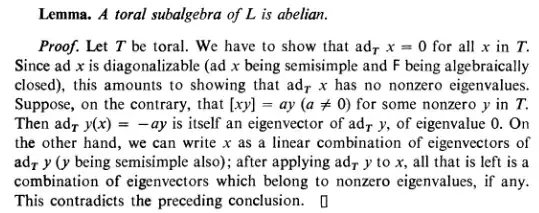I am trying to understand the following argument in Humphreys
I am good with the start of this proof and begin to get shakey here.
(1) $ad_T y(x)=-ay$ is itself an eigenvector of $ad_Ty$, of eigenvalue zero
I think this is because ad_t(y)(ad_T y(x))=ad_T y(-ay)=-a[y,y]=0.
(2) On the other hand, we can write $x$ as a linear combination of eigenvectors of $ad_T y$
I don't understand how why this is true. I know that $x\in T$ so $x$ is a sum of semisimple elements.
(3) after applying $ad_T y$ to $x$, al that is left is a combination of eigenvectors which belong to nonzero eigenvalues
Not understanding the previous step makes this hard to understand. Is this saying all the eigenvalues must be nonzero? or just that there must be some that are non zero? In eithercase why?
This contracdicts the previous conclusion
I do not see the contradiction but this is likey since I have not understood the previous two steps.
Could you please expand on (1), (2), and (3) ideally with comment on my confusions?
This is not a duplicate of this question as we are dealing with different aspects.
